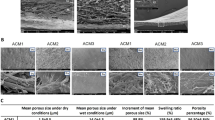Abstract
The effects of acellular dermal graft (AlloDerm®) use on capsular formation due to silicone were studied. Twenty New Zealand rabbits, weighing 2,500–3,000 g, were used in the study. Textured silicone membrane fragments, 2 × 1 cm in size and wrapped with AlloDerm®, were placed subcutaneously in right thoracodorsal regions in the experiment group, composed of ten subjects. In the control group of ten subjects, the naked fragments were inserted into the same locations in left thoracodorsal regions. After a period of 12 weeks, implants, fascia, subcutaneous tissue, and skin were removed en bloc from both groups and examined macroscopically and histopathologically in terms of adhesions to surrounding tissues, capsule thickness, structural properties, the amount of fibroblasts and myofibroblasts, histiocytes, polymorphonuclear leucocytes, and lymphocytes. Statistical analysis of the histopathologic findings was done using Student’s T test. The capsule in the experiment group was found to be thinner and less cellular; this related to fibroblasts and myofibroblasts in comparison to the control group.Preliminary findings in utilizing acellular dermal allograft (AlloDerm®) as a wrap around the implant have shown positive results in minimizing the capsular formation and the possibility of further capsular contraction.





Similar content being viewed by others
References
Sclafani AP, McCormick SAŞ, Cocker R (2002) Biophysical and microscopic analysis of homologous dermal and fascial materials for aesthetic and reconstructive uses. Arch Facial Plast Surg 4(3):164–171
Burres SA (1998) Scar recollagenation. Laryngoscope 108:1394–1397
Arnold SB, Valerie JA (1997) Implant materials. In: Grabb WC, Smith JW (eds) Plastic surgery: general principles, chapter 4. Lippincott-Raven, Philadelphia, p 39–46
J Flood PC, Hobar (1995) Implantation: Bone, cartilage and alloplastics. Selected Readings Plast Surg 8:31–33
Ralph EH (1990) Alloplastic implants. In: Mc Carthy J (ed) Plastic surgery: general principles, chapter 20, vol. I. Saunders, Philadelphia, pp 698–732
Skillman JM, Ahmed OA, Rowsell AR (2000) Incidental improvement of breast capsular contracture following treatment of arthritis with glucosamine and chondroitin. Br J Plast Surg 56:454
Livesey S, Atkinson Y, Call T, Griffey S, Nag A (1994) An acellular dermal transplant processed from human allograft skin retains normal extracellular matrix components and ultrastructural characteristics. In AATB Conference. 20–24 August
Jones FR, Schwartz BM (1996) Use of a nonimmunogenic acellular dermal allograft for soft tissue augmentation: a preliminary report. Aesthet Surg Q 16(3):196–201
Prantl L, Schreml S, Fichtner-Feigl S, Poppl N, Eisenmann-Klein M, Schwarze H, Fuchtmeier B (2007) Clinical and morphological conditions in capsular contracture formed around silicone breast implants. Plast Reconstr Surg Jul 120(1):275–284
Rudolph R, Jerrold A, Woodward M (1978) Myofibroblasts and free silicone around breast implants. Plast Reconstr Surg 62:185–195
La Trenta GS (1994) Breast augmentation. In: Ree TD (ed) Aesthetic plastic surgery, chapter 35. vol. 2. Saunders, Philadelphia, p 1003–1058
Barton FE (1994) Augmentation mammaplasty. Selected Readings Plast Surg 7:9–10
Oymak O (1992) Breast prosthesis. OPC, Istanbul, p 9–11, 15–23, 31–47, 65–77 (Turkish)
Frangou J, Kanellaki M (2001) The effect of local application of mitomycin-C on the development of capsule around silicone implants in the breast: an experimental study in mice. Aesthet Plast Surg 25:118–128
Cek DI, Perk C, Ozcan G (1992) Histologic changes in capsule formation around silicone implants after a single dose injection of amniotic fluid. Eur J Plast Surg 15(6):289–291
Unlu RE, Yilmaz AD, Orbay H, Can B, Tekdemir I, Sensoz O (2007) Influence of rifampin on capsule formation around silicone implants in a rat model. Aesthet Plast Surg Jul–Aug 31(4):358–364
Ibrahim Canter H, Konas E, Bozdogan O, Vargel I, Ozbatir B, Oner F, Erk Y (2007) Effect of slow release 5-fluorouracil on capsule formation around silicone breast implants: an experimental study with mice. Aesthet Plast Surg 31(6):674–679 Jun 19 [Epub ahead of print]
Vinnik CA (1976) Spherical contracture of fibrous capsules around breast implants. Plast Reconstr Surg 58:555–560
Vacanti FX (2004) PHEMA as a fibrous capsule-resistant breast prosthesis. Plast Reconstr Surg 113(3):949–952
Pranti L, Poppl N, Ulrich D, Eisenmann-Klein M (2005) Hyaluronan in sera: a prognostic marker for patients with capsular contracture after aesthetical breast augmentation with smooth silicon gel implants. In 10th Congress ESPRAS 2005. Abstract book pp 118, Vienna
Graaf RM, Bernades A, Rippel R, Araujo LR, Damasio RC, Auersvald A (2003) . Subfascial breast implant: A new procedure. Plast Reconstr Surg 111:904
Vagedis GK (2005) A new pocket for breast augmentation: subfascial technique. In 10th Congress ESPRAS 2005. Abstract book pp 117, Vienna
Dincler MS (2004) The effects of fascial tissue on capsular formation related silicon implants. In XXXIXth Congress of the European Society For Surgical Research. 12–15 May, Athens, Greece. Abstract book no. 141, pp 55
Das SK, Davidson SF, Walker BL (1990) The fate of free autogenous fascial grafts in the rabbit. Br J Plast Surg 315:317
Abenavoli FM, Corelli R (2001) About AlloDerm. Plast Reconstr Surg 108(7):2175–2176
Karacaoglu E (2005) Implant based breast surgery. In 10th Congress ESPRAS 2005. Abstract book pp 118, Vienna
Van Bilsen PH, Papa ER, Brouwer LA, Vincent J, Taylor CE, DeLeij LF (2004) Ongoing foreign body reaction to subcutaneous implanted (heparin) modified Dacron in rats. J Biomed Mater Res 68A(3):423–427
Acknowledgements
We would like to thank Dr. Onder Peker for his invaluable efforts in histopathologic investigations. We also appreciate Dr. Burak Iyigun for his efforts in statistical analysis and Electron Medical, Istanbul/Turquie for their AlloDerm®-providing support.
Author information
Authors and Affiliations
Corresponding author
Rights and permissions
About this article
Cite this article
Uzunismail, A., Duman, A., Perk, C. et al. The effects of acellular dermal allograft (AlloDerm®) interface on silicone-related capsule formation—experimental study. Eur J Plast Surg 31, 179–185 (2008). https://doi.org/10.1007/s00238-008-0222-6
Received:
Accepted:
Published:
Issue Date:
DOI: https://doi.org/10.1007/s00238-008-0222-6




